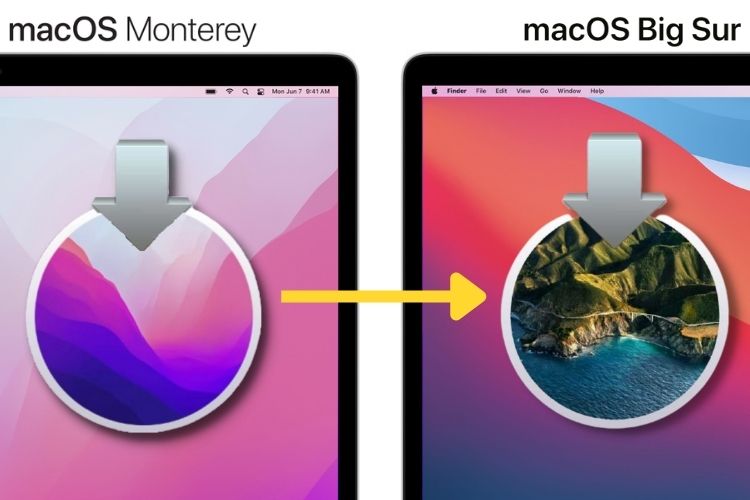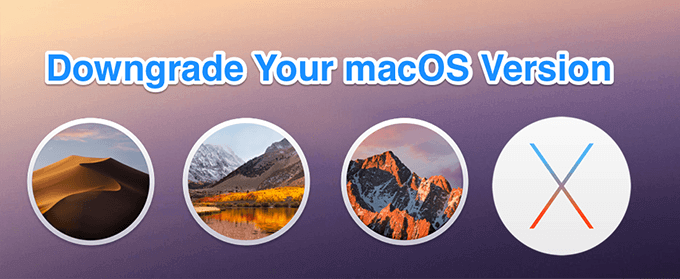
- #Downgrade mac os x using a bootable installer how to#
- #Downgrade mac os x using a bootable installer for mac#
- #Downgrade mac os x using a bootable installer mac os x#
- #Downgrade mac os x using a bootable installer mac os#
- #Downgrade mac os x using a bootable installer update#
The process could take a very long time, depending on the drive.
Type Y to confirm that you want to erase the drive and press return. No text will appear in Terminal when you enter the password. This is the password you use to make changes on your Mac or log in. Enter your administrator account password. Sudo /Applications/Install\ macOS\ Catalina.app/Contents/Resources/createinstallmedia -volume /Volumes/MyVolume The name of the drive can't have any spaces and it is case sensitive.Įnter the following text into Terminal ( Don't forget to change the pathname "MyVolume" if your external hard drive is named something else): If it is not named "MyVolume," you will need to change the command syntax for the pathname where it says: MyVolume. Recall the name of your formatted external drive when entering the following text into Terminal. Scroll down and double click on Terminal. Important:You will need to be in your Mac's administrator account in order to run the sudo Terminal command. Your thumb drive or external hard drive is now ready. Click Done when the process is complete. If Scheme is available, select GUID Partition Map. #Downgrade mac os x using a bootable installer mac os#
Select Mac OS Extended (Journaled) from the format list. Rename your external hard drive MyVolume. Scroll down and double-click on Disk Utility.Ĭlick on the Erase tab at the top of the window. Scroll down and double-click on Utilities. Select Applications from the list on the left side of the window. Click on Finder in your Dock to open a Finder window. Plug the USB end of the drive to a USB port on your Mac. You'll need to start with a clean thumb drive or hard drive in order to get it ready to work as a bootable drive. #Downgrade mac os x using a bootable installer for mac#
Use of this site signifies your agreement to the terms of use.How to format your external drive for Mac
#Downgrade mac os x using a bootable installer mac os x#
While this article was written to advise users upgrading from Mac OS X 10.1.x to 10.2, the additional details it provides on Archive and Install may prove useful for anyone using such.ĭid you find this FAQ helpful? You will find a wealth of additional advice for preventing or resolving Mac OS X problems in Dr. If third-party software doesn't work after the Archive and Install is performed, reinstall it or contact the vendor."Īccordingly, you may want to review the article "Migrate to OS X 10.2 with a Clean Install" from the October 2002 issue of Macworld for additional information, in particular the section therein concerning the Library folder. Some third-party software items may not be preserved. However, per the AppleCare Knowledge Base document on Archive and Install, it states in the Notes section: The Applications folder is preserved - copied intact - as part of the Archive and Install process.
 Repair Permissions using Disk Utility on the hard drive, per Step 3, "Repair Disk Permissions," of the Resolving Disk, Permission, and Cache Corruption FAQ.
Repair Permissions using Disk Utility on the hard drive, per Step 3, "Repair Disk Permissions," of the Resolving Disk, Permission, and Cache Corruption FAQ. #Downgrade mac os x using a bootable installer update#
See the AppleCare Knowledge Base document "Mac OS X 10.2.6 Update Combo: Information and Download."
Apply the Mac OS X 10.2.6 Combo Update. #Downgrade mac os x using a bootable installer how to#
Delete the Previous Systems folder using the instructions in the AppleCare Knowledge Base document "Mac OS X 10.2: How to Delete a Previous Systems Folder.". 

 After Repair Permissions completes, Quit Disk Utility. Select the Repair Disk Permissions button. When Disk Utility opens, select your Mac OS X startup disk from the list of drives and volumes. When the Installer window appears, select Installer > Open Disk Utility from the Apple menu bar. Boot from your Mac OS X v10.2 Install Disc 1 CD. Repair Permissions from the Mac OS X v10.2 Install Disc 1 CD - not the hard drive - as follows:. See the AppleCare Knowledge Base document "Mac OS X 10.2, 10.3: About the Archive and Install Feature." Perform an Archive and Install with the Preserve User and Network Settings option. Your Mac OS X v10.2 Install Disc 1 and 2 CDs. If these instructions do not resolve the problems you are experiencing with the Mac OS X 10.2.8 update, you can downgrade to Mac OS X 10.2.6 using the following procedure. Downgrading from the Mac ® OS X 10.2.8 Update to Mac OS X 10.2.6Īpple® has posted suggested workarounds for the Ethernet-related problems introduced with the Mac OS X 10.2.8 Update in the AppleCare ® Knowledge Base document "Mac OS X 10.2.8: Can't Connect via Ethernet After Installing Update."
After Repair Permissions completes, Quit Disk Utility. Select the Repair Disk Permissions button. When Disk Utility opens, select your Mac OS X startup disk from the list of drives and volumes. When the Installer window appears, select Installer > Open Disk Utility from the Apple menu bar. Boot from your Mac OS X v10.2 Install Disc 1 CD. Repair Permissions from the Mac OS X v10.2 Install Disc 1 CD - not the hard drive - as follows:. See the AppleCare Knowledge Base document "Mac OS X 10.2, 10.3: About the Archive and Install Feature." Perform an Archive and Install with the Preserve User and Network Settings option. Your Mac OS X v10.2 Install Disc 1 and 2 CDs. If these instructions do not resolve the problems you are experiencing with the Mac OS X 10.2.8 update, you can downgrade to Mac OS X 10.2.6 using the following procedure. Downgrading from the Mac ® OS X 10.2.8 Update to Mac OS X 10.2.6Īpple® has posted suggested workarounds for the Ethernet-related problems introduced with the Mac OS X 10.2.8 Update in the AppleCare ® Knowledge Base document "Mac OS X 10.2.8: Can't Connect via Ethernet After Installing Update."








 0 kommentar(er)
0 kommentar(er)
